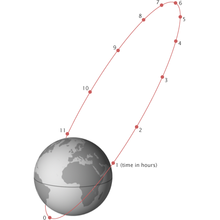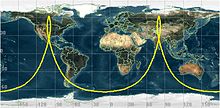Orbit Molniya: Perbedaan antara revisi
Konten dihapus Konten ditambahkan
Dibuat dengan menerjemahkan halaman "Molniya orbit" |
k clean up |
||
| (5 revisi perantara oleh 2 pengguna tidak ditampilkan) | |||
| Baris 1: | Baris 1: | ||
[[Berkas:NASA_molniya_oblique.png| |
[[Berkas:NASA_molniya_oblique.png|jmpl|Figure 1: The Molniya orbit. Usually the period from perigee +2 hours to perigee +10 hours is used to transmit to the northern hemisphere]] |
||
[[Berkas:Molniya.jpg| |
[[Berkas:Molniya.jpg|jmpl|Groundtrack of Molniya orbit. In the operational part of the orbit from apogee −3 hours to apogee +3 hours the satellite is north of 55.5° N (latitude of for example central Scotland, [[Moskwa|Moscow]] and southern part of Hudson Bay)]] |
||
'''Orbit Molniya '''([[Rusia]]: Молния; IPA: [molnʲɪjə] (mendengarkan), "Lightning") adalah jenis [[orbit]] yang sangat [[elips]] dengan [[kemiringan]] 63,4 derajat, argumen dari perigee dari -90 derajat dan [[periode orbit]] satu setengah hari sidereal. Molniya orbit diberi nama setelah serangkaian [[satelit]] [[komunikasi]] Soviet / Rusia Molniya yang telah menggunakan jenis orbit ini sejak pertengahan 1960-an. |
'''Orbit Molniya '''([[Rusia]]: Молния; IPA: [molnʲɪjə] (mendengarkan), "Lightning") adalah jenis [[orbit]] yang sangat [[elips]] dengan [[kemiringan]] 63,4 derajat, argumen dari perigee dari -90 derajat dan [[periode orbit]] satu setengah hari sidereal. Molniya orbit diberi nama setelah serangkaian [[satelit]] [[komunikasi]] Soviet / Rusia Molniya yang telah menggunakan jenis orbit ini sejak pertengahan 1960-an. |
||
Untuk mendapatkan cakupan [[elevasi]] tinggi terus menerus dari belahan bumi utara, setidaknya tiga [[pesawat ruang angkasa]] Molniya yang diperlukan. |
Untuk mendapatkan cakupan [[elevasi]] tinggi terus menerus dari belahan bumi utara, setidaknya tiga [[pesawat ruang angkasa]] Molniya yang diperlukan. |
||
<span class="cx-segment" data-segmentid="44"></span> |
<span class="cx-segment" data-segmentid="44"></span> |
||
== Referensi == |
== Referensi == |
||
* [https://www.agi.com/resources/educational-alliance-program/astro-primer/primer96.htm Molniya Orbits] by Jerry Jon Sellers |
* [https://www.agi.com/resources/educational-alliance-program/astro-primer/primer96.htm Molniya Orbits] {{Webarchive|url=https://web.archive.org/web/20160131094801/https://www.agi.com/resources/educational-alliance-program/astro-primer/primer96.htm |date=2016-01-31 }} by Jerry Jon Sellers |
||
* [http://www.braeunig.us/space/orbmech.htm Orbital Mechanics] by Robert A. Braeunig |
* [http://www.braeunig.us/space/orbmech.htm Orbital Mechanics] by Robert A. Braeunig |
||
* [http://www.astronautix.com/craft/molniya1.htm Molniya-1 spacecraft] by Mark Wade of [http://www.astronautix.com Encyclopedia Astronautica] |
* [http://www.astronautix.com/craft/molniya1.htm Molniya-1 spacecraft] by Mark Wade of [http://www.astronautix.com Encyclopedia Astronautica] |
||
| ⚫ | * [http://wgpqqror.homepage.t-online.de/work.html JAVA applet animating the orbit of a satellite] {{Webarchive|url=https://web.archive.org/web/20110719090338/https://wgpqqror.homepage.t-online.de/work.html |date=2011-07-19 }} in an elliptic Kepler orbit around the Earth. For a Molniya orbit, set the semi-major axis to 26562 km and eccentricity to 0.74105. |
||
| ⚫ | |||
| ⚫ | |||
| ⚫ | |||
| ⚫ | |||
| ⚫ | |||
| ⚫ | |||
| ⚫ | |||
| ⚫ | |||
| ⚫ | |||
Revisi terkini sejak 5 Januari 2023 23.57


Orbit Molniya (Rusia: Молния; IPA: [molnʲɪjə] (mendengarkan), "Lightning") adalah jenis orbit yang sangat elips dengan kemiringan 63,4 derajat, argumen dari perigee dari -90 derajat dan periode orbit satu setengah hari sidereal. Molniya orbit diberi nama setelah serangkaian satelit komunikasi Soviet / Rusia Molniya yang telah menggunakan jenis orbit ini sejak pertengahan 1960-an.
Untuk mendapatkan cakupan elevasi tinggi terus menerus dari belahan bumi utara, setidaknya tiga pesawat ruang angkasa Molniya yang diperlukan.
Referensi[sunting | sunting sumber]
- Molniya Orbits Diarsipkan 2016-01-31 di Wayback Machine. by Jerry Jon Sellers
- Orbital Mechanics by Robert A. Braeunig
- Molniya-1 spacecraft by Mark Wade of Encyclopedia Astronautica
- JAVA applet animating the orbit of a satellite Diarsipkan 2011-07-19 di Wayback Machine. in an elliptic Kepler orbit around the Earth. For a Molniya orbit, set the semi-major axis to 26562 km and eccentricity to 0.74105.
- Real time satellite tracking for a typical Molniya satellite
- 3D Molniya constellation viewer Diarsipkan 2008-04-07 di Wayback Machine. (no longer available)
- illustration of the communication geometry provided by satellites in 12-hour Molniya orbits (video)
